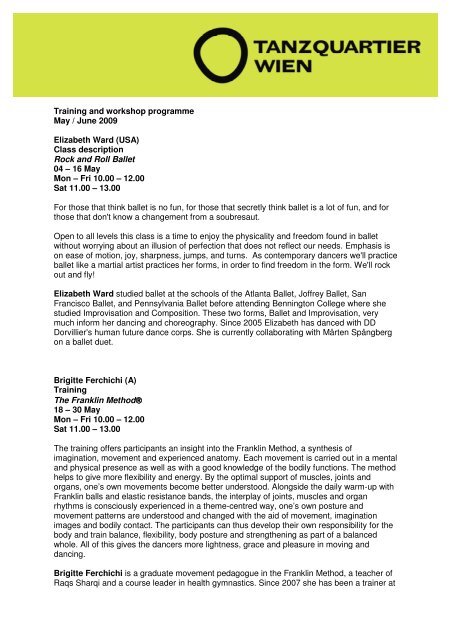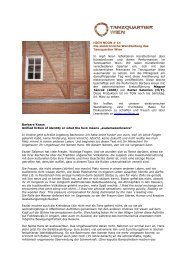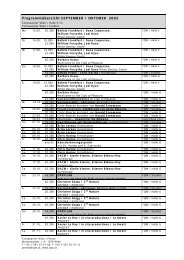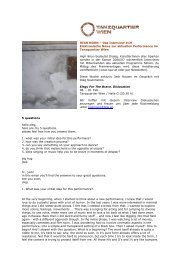Training and workshop programme May / June 2009 Elizabeth Ward ...
Training and workshop programme May / June 2009 Elizabeth Ward ...
Training and workshop programme May / June 2009 Elizabeth Ward ...
Create successful ePaper yourself
Turn your PDF publications into a flip-book with our unique Google optimized e-Paper software.
<strong>Training</strong> <strong>and</strong> <strong>workshop</strong> <strong>programme</strong><strong>May</strong> / <strong>June</strong> <strong>2009</strong><strong>Elizabeth</strong> <strong>Ward</strong> (USA)Class descriptionRock <strong>and</strong> Roll Ballet04 – 16 <strong>May</strong>Mon – Fri 10.00 – 12.00Sat 11.00 – 13.00For those that think ballet is no fun, for those that secretly think ballet is a lot of fun, <strong>and</strong> forthose that don't know a changement from a soubresaut.Open to all levels this class is a time to enjoy the physicality <strong>and</strong> freedom found in balletwithout worrying about an illusion of perfection that does not reflect our needs. Emphasis ison ease of motion, joy, sharpness, jumps, <strong>and</strong> turns. As contemporary dancers we'll practiceballet like a martial artist practices her forms, in order to find freedom in the form. We'll rockout <strong>and</strong> fly!<strong>Elizabeth</strong> <strong>Ward</strong> studied ballet at the schools of the Atlanta Ballet, Joffrey Ballet, SanFrancisco Ballet, <strong>and</strong> Pennsylvania Ballet before attending Bennington College where shestudied Improvisation <strong>and</strong> Composition. These two forms, Ballet <strong>and</strong> Improvisation, verymuch inform her dancing <strong>and</strong> choreography. Since 2005 <strong>Elizabeth</strong> has danced with DDDorvillier's human future dance corps. She is currently collaborating with Mårten Spångbergon a ballet duet.Brigitte Ferchichi (A)<strong>Training</strong>The Franklin Method®18 – 30 <strong>May</strong>Mon – Fri 10.00 – 12.00Sat 11.00 – 13.00The training offers participants an insight into the Franklin Method, a synthesis ofimagination, movement <strong>and</strong> experienced anatomy. Each movement is carried out in a mental<strong>and</strong> physical presence as well as with a good knowledge of the bodily functions. The methodhelps to give more flexibility <strong>and</strong> energy. By the optimal support of muscles, joints <strong>and</strong>organs, one’s own movements become better understood. Alongside the daily warm-up withFranklin balls <strong>and</strong> elastic resistance b<strong>and</strong>s, the interplay of joints, muscles <strong>and</strong> organrhythms is consciously experienced in a theme-centred way, one’s own posture <strong>and</strong>movement patterns are understood <strong>and</strong> changed with the aid of movement, imaginationimages <strong>and</strong> bodily contact. The participants can thus develop their own responsibility for thebody <strong>and</strong> train balance, flexibility, body posture <strong>and</strong> strengthening as part of a balancedwhole. All of this gives the dancers more lightness, grace <strong>and</strong> pleasure in moving <strong>and</strong>dancing.Brigitte Ferchichi is a graduate movement pedagogue in the Franklin Method, a teacher ofRaqs Sharqi <strong>and</strong> a course leader in health gymnastics. Since 2007 she has been a trainer at
the Institute for the Franklin Method. Brigitte Ferchichi was trained in modern dance <strong>and</strong>expressive dance by Gwen Wallace. Her encounter with Raqs Sharqi, a traditional form oforiental dance, was a decisive influence on her further orientation in dance. Since 1996 shehas had numerous stage appearances, performances with groups <strong>and</strong> also as a soloist.Brigitte Ferchichi teaches the Franklin Method <strong>and</strong> Raqs Sharqi in Austria <strong>and</strong> abroad.David Bergé (B/D)WorkshopPhotography for contemporary dancers <strong>and</strong> choreographers19 – 24 JanMon – Wed 12.30 – 17.30In this <strong>workshop</strong> dancers will be introduced to the way photography works: it uses theheightened sense of spatial awareness dancers have, as a starting point; <strong>and</strong> proposes waysto enable two-dimentional or framing awareness. Participants in this <strong>workshop</strong> will doexercises, discuss photographs <strong>and</strong> look how composition supports content. How doeschoreography look like through a camera or can one use a camera to choreograph?Max. 12 participants, full time commitment strongly recommended.David Bergé is a photographer active in the field of contemporary dance <strong>and</strong>performance. Among others, he has been collaborating artistically with choreographers asDD Dorvillier, Jack Hauser <strong>and</strong> Sabina Holzer, Trajal Harrel, Marc Vanrunxt, MegStuart, Kajsa S<strong>and</strong>ström <strong>and</strong> with institutions as P.A.R.T.S., ImPulsTanz, Sarma, TanzplanDeutschl<strong>and</strong> <strong>and</strong> Haus der Kulturen der Welt. www.papa-razzi.beLaurent Chetouane (F/D)WorkshopPresence(s)25 – 29 <strong>May</strong>Mon – Fri 13.00 – 16.30How does one produce movement on stage? What are the possible “generators” behind it?What role does the spectator’s gaze play in this? Is movement always a shifting of the bodythrough the space, a constant rearrangement in a system of coordinates, our could oneunderst<strong>and</strong>/analyse it from the perspective of time or duration? For several danceproductions Laurent Chétouane has been working on the development of a system ofreference that facilitates the production of movement at the intersection of imagination <strong>and</strong>reality, of virtuality <strong>and</strong> materiality. The <strong>workshop</strong> that takes place within Isl<strong>and</strong> No. 9 Givingaway instructions, is an introduction to the concept of this aesthetics inasmuch as variousforms of presence are tried out.Laurent Chétouane (born 1973 in Soyaux/France) is a director <strong>and</strong> choreographer. After hisdegree in engineering he completed a degree in theatre studies at the Sorbonne (F) <strong>and</strong> intheatre direction at the University of Music <strong>and</strong> Performing Arts in Frankfurt/M. Since 2000 hehas given numerous spoken theatre productions (Goethe, Schiller, Büchner, Heiner Müller,Jon Fosse, Sarah Kane <strong>and</strong> Jelinek among others) on major German stages, includingHamburg, Munich, Weimar <strong>and</strong> Cologne. In addition, since 2006 he has been involved in
dance projects – the “Tanzstücke” – in Essen <strong>and</strong> Berlin. He has been a visiting lecturer inGießen, Frankfurt/M., Hamburg, Leipzig <strong>and</strong> Bochum. In 2008 Chétouane received the wildcard of the Ruhr-2010 <strong>and</strong> the North Rhine-Westphalia support prize for outst<strong>and</strong>ing youngartists, <strong>and</strong> in 1999 the Ensemble Prize of the German-language acting schools.www.laurentchetouane.comIngrid Hörlezeder (A)Class descriptionTrager – Mentastics, Somatics <strong>and</strong> Contact Improvisation02 – 06 <strong>June</strong>Tue – Fri 10.00 – 12.00Sat 11.00 – 13.00Every training day begins with exercises in self-awareness. The interior <strong>and</strong> the exterior areexplored. How much space is there between muscles <strong>and</strong> bones, connective tissue <strong>and</strong>arteries? How do our organs, fluids <strong>and</strong> cells move us? How do waves arise? Movementarises out of the ability to feel. Every felt movement leads us into infinity, because our spirit isinfinite. Thus we exp<strong>and</strong> our repertoire of movements by an infinite factor. The approaches tothis come from Bonnie Bainbridge Cohen (BMC) <strong>and</strong> Milton Trager.In his Mentastics (mental gymnastics), the American doctor, Dr Milton Trager, asks: What issimple <strong>and</strong> what would be even simpler than that? What would be nothing? Absoluteeffortlessness? Absolute effortlessness in the body arises by complete ab<strong>and</strong>onment togravity. Bonded to gravity, every movement becomes simple; even complex movementsequences can be mastered effortlessly.Thus we arrive at the contemporary dance form of contact improvisation, whose centralthemes are gravity <strong>and</strong> centrifugal force, as well as contact with a partner. We roll, fly, glide<strong>and</strong> float – effortlessly. From the ab<strong>and</strong>onment to the momentary instant, clear formsdevelop which can be incorporated into any choreography.Mag. art Ingrid Hörlezeder born 1969 in Haslach / Upper AustriaGraduated in:• Music <strong>and</strong> movement pedagogics /University for Music <strong>and</strong> Performing Arts / Vienna• participatory art <strong>and</strong> research/ moving on centre / US• somatic movement therapy/ moving on centre/ US• Trager – awareness <strong>and</strong> movement training / Trager Institute/ InternationalTrainer for contact improvisation since 1994; Organiser of the international contactimprovisation trainers conference Ecite 2006; Appearances as musician <strong>and</strong> dancer since1993, among other places in Brno, San Francisco, Oakl<strong>and</strong> <strong>and</strong> Vienna; real timecomposition is used as a performance technique in music <strong>and</strong> dance; artistic influencescome from Vera Mantero <strong>and</strong> Joao Fiadero as well as from the research of the “nothing”through regular Zen practice.
Ingrid Hörlezeder (A)WorkshopTrager approach to psychophysical integration05. JuniFr 13.00 – 14.30 + 15.00 – 16.30Limited number of paricipants: Three persons per group!In individual sessions there will be the opportunity to experience the Trager approach topsychophysical integration in an individual session. Careful h<strong>and</strong>s accompany themovements, feel the weight <strong>and</strong> send waves that leave an impression of lightness <strong>and</strong>effortlessness in the nervous system. This feeling can be recalled at any time. A Tragersession is recommended for everyone who does not feel fully integrated after an accident orwho would like more lightness, translucence <strong>and</strong> clarity in body <strong>and</strong> mind.Three people come for an hour <strong>and</strong> a half. Each Person receives for 30 minutes theundivided attention of a Trager practician, the other two participants follow the process <strong>and</strong> inthis way learn what happens in a Trager session.Linda Rabin (CAN)Class descriptionContinuum Movement08 – 20 <strong>June</strong>Mon – Fri 10.00 – 12.00Sat 11.00 – 13.00Continuum Movement is an inquiry into the moving intelligence of water. We learn byattending to the fluid expression of our body tissues <strong>and</strong> cells - movements that spiral,spread, curve, pulsate <strong>and</strong> undulate. As our whole organism awakens with internalcommunication <strong>and</strong> resonance, we discover movement is what we ARE <strong>and</strong> not only whatwe do.A typical Continuum session includes explorations with breath <strong>and</strong> sound, micro <strong>and</strong> largermovement, in different relationships to gravity. We take the time to slow down; tune into ourinternal rhythms; pay attention to the felt-sensations below our habitual level of awareness;<strong>and</strong> encourage the body’s intrinsic wisdom to emerge. Continuum invites us to move beyondthe limits of our usual thoughts <strong>and</strong> habitual movement patterns into the flexible, adaptable<strong>and</strong> unpredictable nature of our fluid being.This practice can increase our capacity for easeful movement, reduce our experience ofphysical limitations <strong>and</strong> pain, spark our creativity <strong>and</strong> invigorate our overall health <strong>and</strong> wellbeing. Whether you are a dancer, choreographer, somatic educator, or student of movementof any kind, this approach can enhance <strong>and</strong> bring new perspectives to your personal <strong>and</strong>professional practice.Linda Rabin co-founder of LADMMI, one of Canada’s leading schools in contemporarydance, brings to Continuum more than 40 years of experience in dance, movement
education coaching <strong>and</strong> directing. As a Continuum teacher Linda facilitates artists <strong>and</strong>individuals to realize their personal, creative <strong>and</strong> performance processes. She is also acertified practitioner of Body-Mind Centering®. An international <strong>workshop</strong> leader, Lindateaches in her native Montreal, Canada, Asia <strong>and</strong> Europe. This is the first time Linda isteaching at the Tanzquartier Vienna.For more information about Continuum: www.continuummovement.comSee article: The Movement That We Are: Linda Rabin <strong>and</strong> ContinuumCoaching Workshop15 – 18 <strong>June</strong>Mon – Thur 13.00 – 16.30Each one of us is a unique weaving of morphology, dance training, intuitive <strong>and</strong> instinctiveabilities. The path for learning is equally personal. In this <strong>workshop</strong>, a safe <strong>and</strong> nonjudgmentalatmosphere, we will engage in explorations that reveal our innate tendencies asdancers <strong>and</strong> that open the possibility for greater clarity <strong>and</strong> range. While respecting eachindividual’s personal <strong>and</strong> creative process, we will look into the coherency of the dancer’sintention <strong>and</strong> physical expression. Our learning will include one-on-one coaching, exercisesin duos or trios, group witnessing <strong>and</strong> discussion. Many elements inform the teaching of this<strong>workshop</strong> including concepts from dance, Continuum, BMC, theater <strong>and</strong> voice work.To participate, bring a dance solo excerpt that you have performed or will be performing.Bring a pen <strong>and</strong> notebook, <strong>and</strong> if you like, paper <strong>and</strong> color pastels for drawing <strong>and</strong> coloring.Limited to 8 participants.Jennifer Lacey (USA/F)Class description22 – 27 <strong>June</strong>Mon – Fri 10.00 – 12.00Sat 11.00 – 13.00The principal focus of this morning class is to develop a relationship between bodysensation, effort <strong>and</strong> external form. Exercises integrate specific anatomical directives withbroader poetic images in order to encourage a fluid, active alignment <strong>and</strong> an easy flowbetween internal <strong>and</strong> external attentions. Both the form of the class <strong>and</strong> the exercises willshift over the week, proposing the same concepts through different methods of working.Jennifer Lacey is a choreographer, dancer, <strong>and</strong> teacher from New York City who lives inParis. Her work, often in collaboration with artist Nadia Lauro, is presented regularly in majortheaters, festivals <strong>and</strong> museums internationally. Her experience as a dancer is eclectic <strong>and</strong>includes working with R<strong>and</strong>y Warshaw Dance Co., DD Dorvillier, the Quator Albrecht Knust,Cathrine contour <strong>and</strong> Deborah Hay among others. Her teaching has been influenced by hercontinuing studies with releasing technique pioneer Joan Skinner as well as her interest inyoga <strong>and</strong> qi gong. She has taught classes <strong>and</strong> <strong>workshop</strong>s in many situations including at theEDDC (Arnham & Dusseldorf); SEAD, ISSD (Japan); Movement Reasearch <strong>and</strong> Danspace(New York) <strong>and</strong> Impulstanz (Vienna) among others. Her teaching emphasises form throughsensation <strong>and</strong> action.
Elisabeth Lutz (A)Evening ClassAlex<strong>and</strong>er Technique <strong>and</strong> Vocal Improvisation04 – 20 <strong>May</strong>Mon + Wed each time 18.00 – 19.30Based on the movement ideas of Alex<strong>and</strong>er Technique, which allow us to recognise our ownaction <strong>and</strong> movement patterns, to release tension <strong>and</strong> free ourselves from constrictinghabits, resources can be released for the different <strong>and</strong> the new. Recognise what is, who youare, how you move. Interrupt your habits: stop for a moment what <strong>and</strong> how you always do,move <strong>and</strong> act – new possibilities develop of this of their own accord. The attention focuseson the ability of the body to remember the natural use of the movement apparatus.www.alex<strong>and</strong>ertechnik.atThe game of this evening class: experimenting <strong>and</strong> playing with everything that you makeavailable for movement, vocals, sound <strong>and</strong> rhythm. Getting into contact with oneself <strong>and</strong>one’s own voice, singing, sounding, for oneself, with others. Throwing movement, rhythm<strong>and</strong> voice into one pot, simmering with the heat turned up or turned down, presenting cold orhot. Rediscovering rhythms <strong>and</strong> allowing them to play for movement. Watching, learning,listening, being there in action <strong>and</strong> at rest. Picking up <strong>and</strong> further developing the sounds <strong>and</strong>rhythms in <strong>and</strong> around you. Improvising with yourself <strong>and</strong> your own abilities or joining in withothers in the exchange of sound <strong>and</strong> movement. Where does that lead to? To the discoveryof new spaces, unusual paths, other experiences of movement – what these look like <strong>and</strong>how they shape themselves develops in action. You are warmly invited!Elisabeth Lutz is trained in music <strong>and</strong> movement teaching at the Vienna University of Music/ specialising in percussion <strong>and</strong> conga, Alex<strong>and</strong>er Technique with Melissa Matson in Linz(www.alex<strong>and</strong>ertechnik.at, www.alex<strong>and</strong>er-bewegung.com) <strong>and</strong> movement studies withAmos Hetz in Vienna. Since 1991 her professional activities have included <strong>workshop</strong>s <strong>and</strong>seminars (subjects: rhythm, percussion, improvisation, movement, breathing <strong>and</strong> vocals),Alex<strong>and</strong>er Technique (practice, seminars), teaching activities in training for social welfareprofessions <strong>and</strong> at the Vienna Music University <strong>and</strong> rhythm for children <strong>and</strong> young peoplewith physical <strong>and</strong> mental disabilities (VKKJ association).“I have been living since 1967 <strong>and</strong> never liked sitting down, much preferred to move, at bestoutside where there is no concrete to disturb your feet. At the age of five, wild piano playingfrom next door awakened a great interest in the instrument. Later I learned tamed pianoplaying at music schools, which much later led to struggling to forget how to play only bynotes in order to use the sounds differently again. Singing was always there, the loudest <strong>and</strong>funniest in a fully packed car with my family of five during the many drives between Vienna<strong>and</strong> Burgenl<strong>and</strong>. I most prefer singing together with other people – because of the orchestrayou are surrounded by.What I concern myself with, what I teach <strong>and</strong> pass on involves a lot of improvisation <strong>and</strong> hasdeveloped out of the analysis <strong>and</strong> playing with my own movement development, exploringbreathing <strong>and</strong> sound spaces <strong>and</strong> looking for, finding <strong>and</strong> extending movement-play spaces.The development <strong>and</strong> discovery of new possibilities interests me more than prescribedsolutions. Improvised connections between rhythm, breath, voice <strong>and</strong> movement with <strong>and</strong>without instruments develop out of this. The careful body work of Alex<strong>and</strong>er Technique is agood basis for getting in touch with movement sequences. An important enrichment for me<strong>and</strong> my work are training seminars with Amos Hetz (Movement Studies), Norbert Faller
(breathing school after Middendorf), Keith Johnstone’s theatre improvisations,choreographies by Anna Halprin, Anna Theresa Keersmaeker <strong>and</strong> Rose Breuss, texts by<strong>and</strong> about John Cage, <strong>and</strong> Jonny – the of Barbara Krauss, the discussion <strong>and</strong> livelyexchange with colleagues <strong>and</strong> students– <strong>and</strong> much more that I otherwise experience.”Lilian Genn (A)evening classLaughter yoga as body awareness training for dancers08 – 17 <strong>June</strong>Mon + Wed each time 18.00 – 19.30What effect does conscious laughter have on my body? What changes in my posture, in mybodily awareness, in my emotional state, when I shake my diaphragm energetically?Gelotology, the study of laughter, is discovering ever more advantages: regular laughterliberates, stimulates the immune system <strong>and</strong> the metabolism, strengthens the stomachmuscles, regulates the flow of breathing in <strong>and</strong> out, stimulates the cardiovascular system,activates happiness transmitters <strong>and</strong> improves self-confidence.Laughter yoga, developed by the Indian doctor Dr Madan Kataria, combines breathing <strong>and</strong>stretching exercises with playful exercises to encourage laughter. The principle is “fake ituntil you make it”, act as if the laughter comes on its own. Our body cannot distinguishwhether it is a spontaneous or conscious laughter. Both have comparable physiologicaleffects <strong>and</strong> also put our body in a condition of cheerful composure. Laughter yoga is thus awonderful method quickly <strong>and</strong> effectively to get into the “non-reasoning” state.In the four training units we go on a journey of discovery to find out which potentials can bereleased through conscious laughter. Using the laugher yoga exercises in combination withawareness exercises according to the Franklin Method, we will send a hearty giggling intoour muscles, bones <strong>and</strong> organs, <strong>and</strong> look into the effect that laughing has on dancers’everyday movement <strong>and</strong> training.Lilian Genn was born in Brussels <strong>and</strong> studied sound principles at the Vienna Conservatory.In addition she trained as a suggestologist <strong>and</strong> imaginative dance <strong>and</strong> movement teacheraccording to the Franklin Method. Since 2003 she has developed, staged <strong>and</strong> appeared inmusic education projects: the Bregenz Festival, Jeunesse Austria, the 2006 Mozart Year, theVienna Konzerthaus, the Vienna Musikverein, the Cologne Philharmonic, the LuxembourgPhilharmonic etc. In addition, Lilian Genn specialises in body awareness <strong>and</strong> appearancetraining for orchestra/musicians (Vienna Chamber Orchestra, lecturer at the Bregenzacademies with masterclasses of the Vienna Symphony Orchestra). Lilian was infected bythe laughter virus in 2004 at the Vienna Academy of Laughter – since then she has been anenthusiastic laughing yogi. She leads laughter yoga groups <strong>and</strong> incorporates laughter <strong>and</strong>the peaceful philosophy of laughter yoga into her artistic projects <strong>and</strong> body work.









